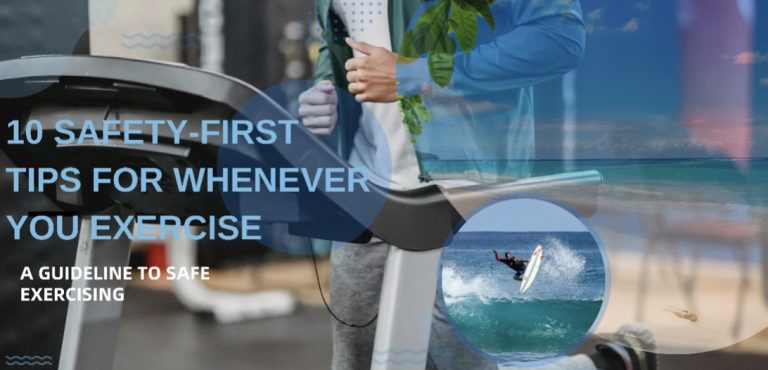The last thing you need as you do your exercise routine is a nasty injury. Unfortunately, without learning proper technique, using safety gear when necessary, or even just adhering to some good old precautions, you stand a high risk of exerting injury to yourself.
The environments and situations in which we exercise are usually different. For example, you might not need to take the same precautions when you are in a gym as opposed to when you’re hiking. That might appear as common knowledge; however, injuries when exercising are a commonality.
Story Stages
Keeping Yourself Safe During Exercise
Gym injuries are a common occurrence, with studies showing nearly half of gymgoers experience some type of training-related injuries and mishaps at least once a year. Let’s explore what fitness experts, professional athletes, and coaches have mused about what safety whenever exercising looks like. This will possibly include both injuries sustained due to possible mishaps and injuries sustained during the actual exercise.
1. Learn the Rules
Rules do matter, and if you do anything you must do it properly. If you’re thinking “How to write my paper” on any topic, you have to adhere to the set academic rules for essays, research papers, etc. Likewise, with any type of exercise or training routine, follow the advice of practitioners on the type of exercise that you’re doing. It might just save you an injury or two.
2. No Ego Lifting
One of the key reasons for gym-related injuries is trying to lift above their possible strength class. Notice here we said “strength” as opposed to “weight”. Yes, it is true and generally recommended to lift at or slightly above your weight category. That’s a safety net; however, exceptions do occur and you may come across someone who has an exceptional strength-to-weight ratio. What that means is, say, a 150-pounder being able to bench 250 pounds upwards.
This leads to the next safety tip;
3. Always Brace for Heavy Weights
If you can, always try to brace yourself. This could be anything from your back, your knees and shoulders, to your head with a helmet if necessary.
Try up-lifting first, meaning, try to lift incremental weight classes until you feel comfortable with heavier weights. Also use supports like belts, straps, and wraps if you need to. If you are not comfortable with a certain weight, also use a spotter.
4. Warm-up Wisdom
Warming up is not emphasized enough, especially for folks training in colder environments. Soft tissue that is cold is less flexible and more prone to strain and tear. A combination of general and specific warm-ups, including light calisthenics and exercise-specific routines, is crucial for injury prevention.
5. Form Matters
Even the safest exercises require proper form. Ergo, try to learn from your predecessors in that particular routine. This always helps as you can stick to best practices without having to risk injury. For the brave-hearted and curious, you can try different postures to figure out what works.
While minor form errors are common, major deviations can lead to injuries. Try having a spotter if in the gym and especially when using barbells and dumbbells to check on your posture occasionally. Adjust your working weights to maintain good form, and if needed, seek coaching, and yep -YouTube tutorials do help sometimes to improve your technique.
6. Avoiding Extreme Temperatures
Back to the weather and how it impacts exercise. You might be thinking of going David Goggins-style and training in extremes. However, intense exercise in excessive cold or heat poses risks and is generally not recommended especially for aging athletes.
Extreme temperatures affect tissue temperature and circulation, making soft tissues more prone to injury. Find a well-ventilated environment with a comfortable temperature for your workouts.
7. There Are Levels to It

Just because you saw someone else doing it doesn’t mean you should as well. At least train for it first. Or, at least ask them how they can do it with ease. This is especially true if the person is in nearly the same weight class as yourself and can lift much heavier weights. The same principle of learning proper technique from the vets applies to all types of exercise.
8. Be Conscious of Your Health and Medical Condition
Studies have explored in minor detail what percentage of the sample groups had an underlying condition before experiencing an aggravated injury while exercising. To get such an explorative study for yourself or as a sample, you can choose to pay for essay from a reputable service.
Are there any underlying or old injuries and conditions that you are aware of? For example, if you suffer from asthma, always carry an inhaler wherever you exercise. Remember to be conscious about your general body condition because intense exercise can aggravate injuries. For example, it is generally recommended for individuals over 50 years old to do modified weight exercises. Again, this much depends on the person’s health and general body condition.
9. Train with Recovery in Mind
Recovery is essential to the training process. Muscles need time to relax and heal after being broken down. This means rest, sleep, and enough food to cover the calorific loss per exercise session. More specifically, recovery starts right after exercise, where you can do stretching exercises to improve blood flow, increase flexibility, and reduce soreness.
Avoid training under unfavorable conditions like being fasted, sleepless, sick, dehydrated, or distracted. Ensure your body has adequately recovered before pushing it further. Also, rest between sets to let your muscles metabolize and start the recovery process.
10. Listen to Your Body
As you become more familiar with certain exercise routines and how your body naturally reacts to them, learn to differentiate between minor discomfort and potential injury. If something doesn’t feel right, stop, evaluate, and, if necessary, consult with a coach or healthcare professional. Remember, it’s okay to pause and prioritize long-term safety over immediate gains.
Final Gym Safety Disclaimer
These are more precautions when exercising; always work in a well-ventilated room that is clean and free from spilled liquids. Always use equipment that has been calibrated or balanced. Finally, avoid training when under the influence or by incorporating risky equipment and routines. Use a well-rated gym if you are an absolute noob who knows nothing about safe exercising.
Final Words
Safety is a priority whenever you exercise, regardless of the type of exercise. We’ve covered some general safety-first principles and nuggets on how to keep your safety on top purposefully, before and after exercising. Some precautions have been underlined, including using supports such as braces or even a spotter, and knowing your general medical condition.
Safety doesn’t end there. As you move past being a novice to more of a regular and eventually a true pro in a particular routine, you’ll learn what works and what doesn’t. Experience and consistency definitely form the best type of safety. Adios!
